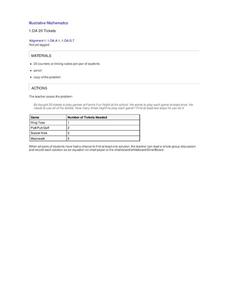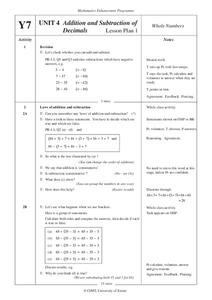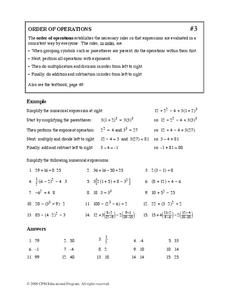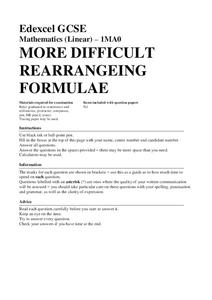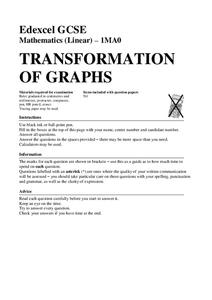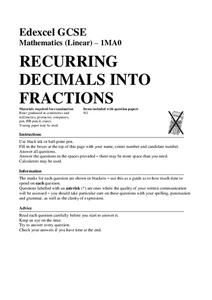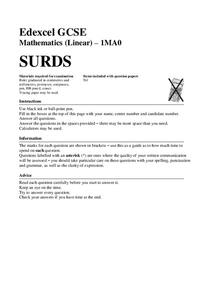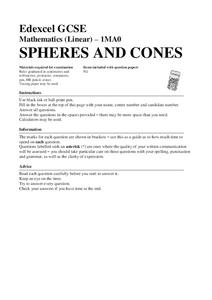Pennsylvania Department of Education
Using Polygons to Represent Fractions
Explore the world of fractions by using pattern blocks to show how different shapes can divide a hexagon. Elementary schoolers work in groups to complete these problems and to answer questions. Later, they work complete an independent...
Curated OER
Chairs Around the Table
Youngsters become flexible problem solvers with this challenging lesson. If there are 24 square tables in a restaurant, how many customers can be seated at one time? They can use manipulatives or draw pictures to help them find the...
Curated OER
20 Tickets
A great hands-on activity involving adding and subtracting, beginner mathematicians determine how many games can be played with 20 tickets. Instead of tickets, youngsters use 20 counters or linking cubes to represent the amount of...
Computer Science Unplugged
Count the Dots – Binary Numbers
Did you know you can send a message using only zeroes and ones? This interactive resource presents an introduction to binary numbers. Through code cards, pupils learn to convert binary numbers to decimal numbers.
Curated OER
Order of Operations
Review the order of operations using this worksheet. Learners complete eighteen problems involving addition, subtraction, multiplication, and division.
Curated OER
Common Factors and Factorising
Middle schoolers read through four examples that demonstrate factorisation. They work through five practice problems. Finally, pupils complete 31 factorisation questions. The worksheet is graded at the bottom. Note: The British spelling...
Curated OER
Addition And Subtraction of Decimals
Learners participate in a lesson of adding and subtracting decimals. They should review place values with decimals before beginning the lesson. The lesson plan also includes sample problems for the teacher to use in direct instruction....
Curated OER
Children's Literature Across the Curriculum Ideas-Dancing With the Indians
Students read Dancing With the Indians by Angela Shelf Medearis. They complete a variety of cross-curricular activities surrounding the study of Native American festivals and traditions. Included are reading, art, math, science, writing,...
Curated OER
Order of Operations
In this order of operations worksheet, students read an explanation of the order of operations and are taught to use the acronyms BODMAS and BIDMAS to solve these types of problems. Students then answer 45 questions in which they must...
CPM
Order of Operations
Middle schoolers solve problems that include applying the order of operations to each expression. A nice review of the process is provided in a box at the top of the page, but it does not follow the PEMDAS acrostic. There are 15...
Teacher Created Resources
PEMDAS: Order of Operations
Learners complete algebraic equations. They learn the algebraic order of operations and the acronym, PEMDAS, to help them remember the correct order of operations. Pupils complete algebraic equations using the order of operations.
Mathed Up!
Cumulative Frequency and Box Plots
Learn how to display data. Young data analysts watch a video to review how to create cumulative frequency histograms and box plots. They work on a set of questions to practice producing these data displays.
Mathed Up!
Simultaneous Equations
How do you solve systems of linear equations? Scholars watch a video to learn how to solve systems using elimination-combination. After viewing the video, they solve seven systems of equations.
Mathed Up!
Quadratic Formula
Young scholars explore how to solve any quadratic equation with a video about the quadratic formula. They then use the quadratic formula to solve a set of quadratic equations.
Mathed Up!
Algebraic Fractions
Learn ways to simplify algebraic fractions with a video that reviews how to simplify rational expressions by canceling common factors and how to add and subtract simple rational expressions. A worksheet tests pupils' understanding...
Mathed Up!
More Difficult Rearranging Formulae
How do you solve equations with more than one variable? Scholars view a video that explains solving literal equations as simply an extension of solving simple equations. Once they have a handle on the concept, they work on several...
Mathed Up!
Simultaneous Equations with a Quadratic
Viewers discover how to solve quadratic-linear systems with a video that first explains the substitution method for solving a system of equations involving a quadratic. Scholars then complete a worksheet of practice problems.
Mathed Up!
Transformation of Graphs
In what ways can you transform a graph? An engaging video answers this question as it covers reflections, translations, and stretches of graphs. To test their knowledge, individuals complete a set of problems to apply this knowledge.
Mathed Up!
Sine and Cosine Rules and Area of Triangles
Learners discover how to find missing sides and angles using trigonometry. Scholars first watch a video covering the Law of Sines and Cosines, as well as the area formula for a triangle. To test their knowledge, they complete a worksheet...
Mathed Up!
Recurring Decimals
Explore how to convert repeating decimals to fractions with an informative video that teaches young mathematicians how to translate between decimals and fractions. After viewing, individuals complete a set of problems to practice...
Mathed Up!
Surds
Young mathematicians learn how to simplify expressions with square roots by watching a video that shows several ways to rewrite expressions involving radicals. They work on questions where they rationalize denominators and expand and...
Mathed Up!
Direct and Inverse Proportionality
Direct your young mathematicians to a resource on direct and inverse variation. A video first reviews concepts on direct and inverse proportionality. Individuals then answer a set of questions in pure and applied mathematics...
Mathed Up!
3-D Pythagoras
Apply the Pythagorean Theorem in three-dimensional shapes. Young mathematicians watch a video that takes them through several examples of using the Pythagorean Theorem to solve problems involving lengths in three-dimensional figures. A...
Mathed Up!
Spheres and Cones
Class members learn how to apply formulas for spheres and cones with a video that begins with a review of the formulas for surface area and volume of spheres and cones. Pupils use these formulas to solve problems on a worksheet.




